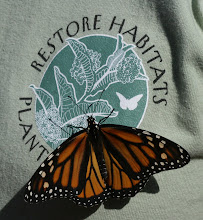 We woke up to a very chilly morning with temps barely 50 degrees and walked through Butterfly Grove. It was the morning after the storm. A few monarchs were on the ground, likely downed from the wind and rain, unable to move until they warmed up. Grounded monarchs are in a dangerous position. As a survival mechanism, they will often crawl up a nearby tree or stick a bit off the ground if they can’t fly to protect themselves from predators. But the monarchs we saw today m
We woke up to a very chilly morning with temps barely 50 degrees and walked through Butterfly Grove. It was the morning after the storm. A few monarchs were on the ground, likely downed from the wind and rain, unable to move until they warmed up. Grounded monarchs are in a dangerous position. As a survival mechanism, they will often crawl up a nearby tree or stick a bit off the ground if they can’t fly to protect themselves from predators. But the monarchs we saw today m ay have been too wet or too cold to even crawl to safety. Fortunately as the sun warmed they were able to fly to the lower branches of the tree to continue sunning.
ay have been too wet or too cold to even crawl to safety. Fortunately as the sun warmed they were able to fly to the lower branches of the tree to continue sunning.
We found the monarchs in a few small clusters on the north side of the trees. Usually they would line up on the south, but they used the eucalyptus trees for protection from the storm’s winds.
The hot topic of conversation today was the tree pruning at Pacific Grove. We overheard several conversations of deep concern for the monarch’s future at Pacific Grove. We spoke to one docent who was there when the arborist instructed the city pruners. It was his opinion that the arborist primarily wanted to prevent any falling limb danger to neighboring structures. But we think if a monarch specialist had been consulted the impact may have been less. Time will show if the city made a serious mistake or not.

It's likely hard to imagine the importance of the monarch butterfly to Pacific Grove's economy. Known as "Butterfly City," tourists during the overwintering season are a primary revenue source for the area. Signs with monarchs grace the area, everything from the Chamber of Commerce, businesses to local street addresses. It's a haven for monarch lovers to feel at home.
We stopped by the Pacific Grove Natural History Museum that features a permanent monarch exhibit and gift shop. You can just imagine the time (and money) we spent there! We met several people who were very involved in the local movement to protect the monarch butterflies. The tree pruning broke their hearts. But it’s encouraging to talk to people dedicating their time to help preserve monarch butterfly habitats.Then we took a leisurely drive up the coast to Santa Cruz then enjoyed a short walk in the Redwood Forest.
We met Paul Cherubini in person for the first time over dinner and had a most delightful evening! Paul is a walking book of monarch information and always offers an interesting perspective. He often challenges the status quo with his keen observations and meticulous record-keeping and photographs. His love of monarchs runs deep and he helped us understand Phoenix and Arizona as well as the local California counts. Paul helped us better understand the role of autumnal sites in overwintering communities, diapause and reproducing monarchs, new local overwintering sites, and the possible effect of low predators in the larger cienega monarch reproducing sites in Arizona. We also talked with Paul, as we did with David Marriott, about the strange phenomena we experienced at home with a female monarch appearing to be laying eggs on a Desert Milkweed (abdomen pressing against the stem) but no eggs deposited at the site. It seems that a female monarch may have an instinctive response to milkweed that promotes this behavior. Maybe the female was immature, not gravid. Interesting. This is just a small sampling of the monarch conversation we had with Paul. What a great evening!
Phoenix and Arizona as well as the local California counts. Paul helped us better understand the role of autumnal sites in overwintering communities, diapause and reproducing monarchs, new local overwintering sites, and the possible effect of low predators in the larger cienega monarch reproducing sites in Arizona. We also talked with Paul, as we did with David Marriott, about the strange phenomena we experienced at home with a female monarch appearing to be laying eggs on a Desert Milkweed (abdomen pressing against the stem) but no eggs deposited at the site. It seems that a female monarch may have an instinctive response to milkweed that promotes this behavior. Maybe the female was immature, not gravid. Interesting. This is just a small sampling of the monarch conversation we had with Paul. What a great evening!

 ay have been too wet or too cold to even crawl to safety. Fortunately as the sun warmed they were able to fly to the lower branches of the tree to continue sunning.
ay have been too wet or too cold to even crawl to safety. Fortunately as the sun warmed they were able to fly to the lower branches of the tree to continue sunning.
 ay have been too wet or too cold to even crawl to safety. Fortunately as the sun warmed they were able to fly to the lower branches of the tree to continue sunning.
ay have been too wet or too cold to even crawl to safety. Fortunately as the sun warmed they were able to fly to the lower branches of the tree to continue sunning.
No comments:
Post a Comment